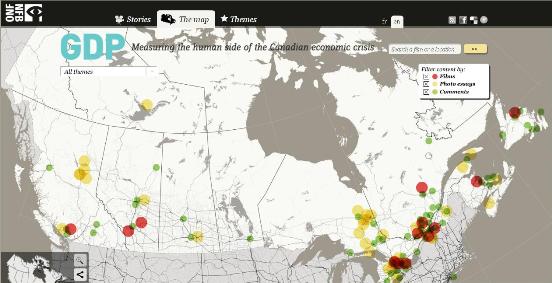The producers behind Canada’s GDP Project are hardly the first to represent historic change by telling individual stories. But their effort, done under the auspices of the National Film Board, is a surprisingly comprehensive one-year attempt to document the Canadian people’s struggle for stability.

A dozen filmmakers are following 15 main characters in monthly or bimonthly installments, while photographers collect images and audio in other locales. The material is edited centrally in Montreal under the supervision of documentary filmmaker Hélène Choquette and loaded onto the project site. The project is designed to live on the Web, though Dupont says it could eventually take another form, such as a longer film, after the year is over.
An interactive map shows where the economic dispatches are coming from, and the site is bilingual, with a fully French-language version and media in both languages with subtitles. Viewers can add content and comments of their own. Media gets posted while the project is underway, leading to an unusual storytelling conundrum. Dupont wrote us to say
“Our 15 main characters (those we’re following throughout the year) are involved in a very unusual reflexive experiment, i.e. they can watch their “testimonial” almost instantly on our Web site, and can also notice afterwards what’s written or posted by the users with regard to the films in which they’re being featured. Since they don’t have any clue about what’s going to happen next in their lives or what’s to be filmed, they deal with a great deal of uncertainty as well as their own judgment on their “appearance” online, what they say every month and agree to share with the “audience.” The character is here being a character and a spectator at the same time. We’re not in reality TV though, because this project stands on strong documentary ethics.”
While Dupont volunteered that sometimes the economy is “not a sexy topic,” she’s pleased with the response the site has gotten thus far, with nearly 50,000 unique visitors since September 2009 and more than 250 comments to date. (Sometimes those comments make their own intriguing statement.) Not every episode is enthralling, but the project’s refusal to record a pre-ordained view of what Canadians’ response to the economic crisis should look like is refreshing. There is little effort to make individual subjects into icons.
Narrative is much easier to shape after the fact, once all the material has been gathered and it’s clear how the story will end. But rolling out content in near “real-time” is more interactive and feels more organic to the Web than the classic documentary approach. It's a bold experiment.
[Read a Q&A from a phone interview with Marie-Claude Dupont about the GDP Project.]


